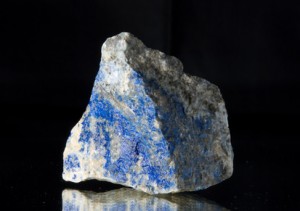Lapis lazuli is the stone that decorated the headpieces and sarcophagi of ancient pharaohs, was carved into decorative sculptures and vases, and was ground into pigment for Cleopatra’s eyeshadow and masterpieces in oil paint.
Lapis lazuli gets its physical properties from several different minerals, including lazurite, mica, pyrite and calcite.

Lapis lazuli crystal
It usually forms inside crystallized limestone as the result of trapped chlorine’s interaction with intense magma.
The heat changes the stone’s chemical properties, accounting for its rich blue shade.
Where to Find Lapis Lazuli?
While lapis lazuli is primarily mined in Afghanistan, strains of it have been found in the Americas — as far north as Canada and as far south as Chile and Argentina.
In the United States, most deposits are located in California and Colorado.
California actually has a commercial lapis lazuli mine, the Big Horn Mine, located near Wrightwood. Lapis lazuli also has been mined at Crested Butte, Colo.
Individuals should hunt in geographical areas known to produce crystallized limestone and marble, as lapis lazuli will often be found with them.
For those who like to travel as part of a mining hobby, veins of lapis lazuli can also be found in Russia, Siberia, Pakistan, India, Burma and Italy.
How Can You Tell You Have Found Authentic Lapis Lazuli?
It might be hard to differentiate lapis lazuli from other blue gemstones found in nature, such as turquoise, blue quartz or azurite.
True lapis lazuli will contain some thin streaks of white calcite or glittery gold flecks of pyrite.
Quality stones will only feature small traces though. The blue shade, which ranges from brilliant royal to a deeper navy, should be the predominant color.
Lapis lazuli will also release a telltale rotten egg smell when exposed to hydrochloric acid, so those looking for it in nature should carry a small amount of the acid in a field kit.
Uses of Lapis Lazuli
Once an individual finds some lapis lazuli, they might not know how best to utilize it.
First and foremost, a polished lapis lazuli stone makes for some stunning jewelry and is often set in gold to accent the gold pyrite spun throughout its surface.
Even small lapis stones can have a strong visual impact when fashioned into pendants and delicate drop earrings.
Lapis lazuli also has been used historically for its healing powers. In ancient Egypt, lapis lazuli was carved into the shape of an eye, the “third eye,” and was meant to awaken intuition.
It has also been used in Hindu culture to open the throat chakra and promote healing of the thyroid, throat, gums and neck vertebrae.
It is believed that lapis lazuli stones used for healing purposes need to be recharged in sunlight for at least an hour to be effective over time.
Lapis lazuli can also be ground into pigment for unique clothing dyes. Though it was once used in oil and tempura paint, the process has become too expensive and is reserved for professionally restoring ancient paintings.














